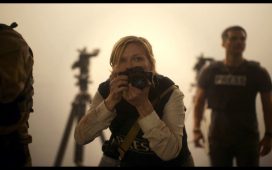“There was once a happy little chorus girl who lived alone in a garret, and there was a lonely boy in the attic above, who wrote tales nobody wanted, except perhaps the girl.” The chorus girl is called Tip-Toes, and she is destined for great stardom. The young man, not so much.
This is the fairytale scenario for a movie made in 1923 by George Pearson, an ambitious, occasionally self-aggrandising British director. It is a scenario that he reprinted in his florid autobiography, Flashback. The cheery chorine was to be played by Pearson’s protege, and one of the biggest stars in British silent cinema, Betty Balfour. The resulting film, Love, Life and Laughter, combines whimsy with realism to tell a story about optimism and ideals. Most importantly, it is a bespoke star vehicle for Balfour.
Love, Life and Laughter opened to some impressive, if reserved reviews. The Manchester Guardian’s CA Lejeune accused it of “tickling the intellectual vanity of its audience with a goose feather, coloured peacock by imagination”, but said it was “ambitious, spectacular … lit and photographed with a beauty to dream of”. Nevertheless, she rightly predicted it would be a hit.
Unfortunately, Love, Life and Laughter soon became one of the great casualties of the silent era. For decades, it was thought to be lost, and was placed on the BFI’s list of “most wanted” films. So when a copy was discovered in the Netherlands in 2014, legions of Balfour fans, who had precious few chances to see her on screen, celebrated. And now the film has been restored by specialists at the BFI Archive and will have its world premiere at the London film festival in October, with live musical accompaniment by Meg Morley, the acclaimed jazz composer and pianist. Morley is also an expert in the art of improvising for silent cinema, and although, of course, this film has no soundtrack, its subject matter means that music takes on a vast importance.
Balfour was an expressive comic with an infectious smile, and the historian Rachael Low wrote that she was “able to register on screen a charm and expression unequalled among the actresses in British film”. Not surprisingly, she was once thought to be the feather in the cap of our national film industry. She led a successful film franchise, playing a cockney flower-girl called Squibs, acted for Alfred Hitchcock in his silent film Champagne and was popular with audiences and directors all over Europe. However, she found it hard to shake her cockney typecasting and her career faltered in the sound era. She died in 1977, aged 74, and by the turn of the 21st century the reputation of the woman once known as “Britain’s Queen of Happiness” had gradually diminished – simply because the films she made were hard to see.
So what can we expect from Love, Life and Laughter? Balfour’s presence on screen is as magnetic as it is charming; if you have not seen her before, you may be surprised by the energy of her performance. She is constantly in motion, eyes twinkling and limbs snapping: a gamine with get-up-and-go. In this rags-to-riches story, she plays in the working-class mode for which she was most famous, but when she bursts out of that slum to become a star, she can indulge in the elegant 1920s glamour that suited her so well.
It is a sentimental film, with a story-within-a-story narrative, and a central motif provided by a balloon-seller who lives in Tip-Toes’s tenement building: “The ’opes of young people is like the air in balloons,” he says. “The more ’ope, the ’igher you goes. Too much ’ope – bust!” Tip-Toes becomes a star while the author suffers rejection, but even at the height of her fame she misses him and remembers their promise to meet again. There are still some segments of the film missing – about 20 minutes over the course of the feature – mostly, it is thought, dealing with the young man’s story.

There are some fascinating intersections of early 20th-century musical culture at play here, too. Pearson’s first inspiration for the film was Marie Lloyd, the music-hall star from east London who was celebrated for singing favourites such as The Boy I Love Is Up in the Gallery and My Old Man (Said Follow the Van), as well as for her saucy use of innuendo. Lloyd died a few days after collapsing on stage at the Alhambra theatre, Leicester Square, in 1922. That was just two years after Pearson first saw Balfour perform in the same venue and hired her for his film Nothing Else Matters (1920).
In Love, Life and Laughter, Balfour dances and sings Oh! My Sweet Hortense, a popular American song first published in 1921 (“she ain’t good-lookin’, but she’s got good sense”) to her friends around the piano. In a Dutch print that survives, the song has been switched to Yes, We Have No Bananas – no doubt due to that song’s massive popularity on its release in 1923. It is a simple change in a silent film, just a matter of changing what is written on the title cards. So, likewise, Dutch audiences were told that the central character was called Squibs rather than Tip-Toes, rather like pretending Daniel Craig is always playing James Bond, no matter what the movie. In a different scene, Tip-Toes takes the young man to a jazz bar, where neon lights sizzle, a dancer performs the Shimmy, and a band plays the night away.
Love, Life and Laughter is always poised between two worlds: success and failure, rich and poor, and the traditional and the modern. Just the kind of film that it is most exciting to revisit, with fresh eyes, nearly a century after it was first seen. It is certainly the kind of fairytale ending that Pearson would appreciate for this showcase for his favourite star.
Love, Life and Laughter (1923) is at the BFI London film festival on 3 October













